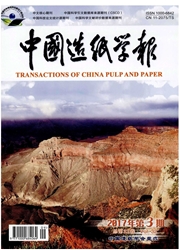

 中文摘要:
中文摘要:
研究了棉短绒浆、竹浆、阔叶木浆和针叶木浆(均为溶解浆)的纤维素在氢氧化钠/尿素/水体系中的溶解差异,棉短绒浆和竹浆的纤维素溶解后可形成均一的液相体系,而阔叶木浆和针叶木浆的纤维素溶液有分层现象,说明同等条件下棉短绒浆和竹浆的纤维素溶解度较大。4种天然纤维素再生后聚合度和结晶度均有一定程度的降低,棉短绒浆和竹浆的纤维素聚合度从549、624降低至474、555,分别降低了13.6%和11.1%;而针叶木浆和阔叶木浆再生后纤维素的聚合度降低不明显,分别从1067、1460降低至989、1419,只降低了7.3%和2.8%;棉短绒浆和竹浆再生后纤维素结晶度降低的幅度比较大,从66.5%和79.7%降低到18.8%和31.8%,分别降低了71.7%和60.1%;阔叶木浆和针叶木浆再生后纤维素结晶度降低的幅度较小,从76.4%和70.4%降低至62.5%和54.7%,分别降低了18.2%和22.3%;阔叶木浆和针叶木浆的纤维素由于聚合度较大,该体系不能降低其结晶度,因而其溶解度小于棉短绒浆和竹浆的纤维素。处理前后纤维素的红外光谱图基本一致,说明纤维素在该体系溶解过程中并未引入新的基团,氢氧化钠/尿素/水体系为非衍生化纤维素溶剂;处理后,几种样品纤维素Ⅰ的峰强度降低甚至消失,纤维素Ⅱ的峰开始出现,说明用该体系进行处理可使纤维素晶体结构发生转变。
 英文摘要:
英文摘要:
The solubility of four celluloses (cotton linter pulp, bamboo pulp, hardwood pulp and softwood pulp) in NaOH/urea aqueous was studied. Cotton linter pulp and bamboo pulp were soluble and formed an uniform liquid system, whereas a layered solution was formed for hardwood pulp and softwood pulp, indicating that the solubility of hardwood pulp and softwood pulp were lower in the aqueous system. The degree of polymerization and the degree of crystallinity of all four celluloses were decreased after dissolving-regeneration. The degree of poly- merization of cotton linter pulp and bamboo pulp celluloses decreased from 549 and 624 to 474 and 555, a reduction by 13.6% and 11.1% , respectively; whereas the degree of polymerization of hardwood pulp and softwood pulp celluloses decreased from 1067 and 1460 to 989 and 1419, a reduction by only 7.3% and 2.8%, respectively. The degree of crystaUinity of cotton linter pulp and bamboo pulp celluloses de- creased from 66.5% and 79.7% to 18.8% and 31.8%, a reduction by 71.7% and 60.1% respectively; whereas those of hardwood pulp and softwood pulp celluloses decreased from 76.4% and 70.4% to 62.5% and 54.7%, a reduction by 18.2% and 22.3%, respectively. These results indicated that the solubility difference of four celluloses can be attributed to the fact that the solvent system can not reduce the crystallinity of hardwood pulp or softwood pulp celluloses because of the high degree of polymerization. The infrared spectra of these materials showed that new groups do not appear after dissolving-regeneration, indicating that the NaOH/urea system is not a cellulose derivative solu- tion. X-ray diffraction (XRD) showed that the regenerated cellulose is converted from cellulose Ⅰ to cellulose Ⅱ, this system can cause a change of cellulose crystal stracture.
 同期刊论文项目
同期刊论文项目
 同项目期刊论文
同项目期刊论文
 期刊信息
期刊信息
